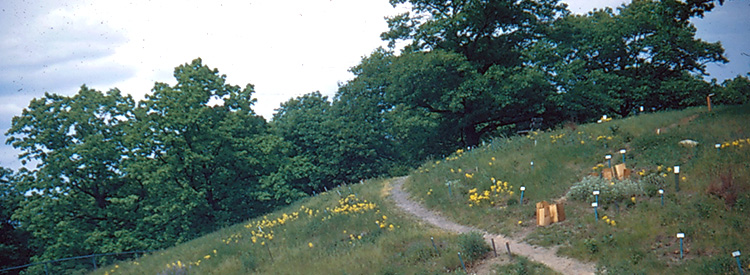
1948
History
of the Eloise Butler Wildflower Garden
1948 is the 42nd year of the Garden and Martha Crone began her 16th year as Garden Curator.
NOTE on historical garden photos: From 1948 to 1957 Martha Crone assembled a collection of Kodachrome slides that she took of plants and landscapes of the Wildflower Garden. The assemblage eventually totaled over 4,000 slides. She used these slides to give illustrated lectures about the Garden to various clubs, groups and organizations. Martha Crone was a founding member of the Friends of the Wild Flower Garden, a director from 1952 to 1972 and an honorary life member thereafter.
After her death in 1989 her daughter Janet, passed the collection to the Friends via Friends member Martha Hellander who was in the process of researching a book about Eloise Butler. The Friends sorted the collection and then for a short time, used them at lectures about the Garden. Some of those images are shown on this page.
Many new plants set out in 1948 are, again like 1946 and ’47, non native, apparently an attempt to see what would grow in the new prairie area. Many did not last until the 1951 census. The source is given for some of new plants. Most of this year’s history is concerned with the new plants Martha introduced.
With the development of the Upland Garden, it is incredible the amount of planting Martha Crone did in 1946-1948 and little wonder that her log is virtually devoid of mentioning bird activity, which she usually never neglected. Even the warbler migration is not noted this year. Birds are only mentioned four times. Martha religiously noted the arrival of the first Hummingbird and the departure of the last except this year there is no mention of the last.
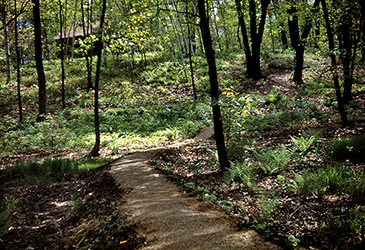
The first Garden Log entry for the season is on April 1st, opening day:
Not a trace of snow, altho ice on lakes and pools, no plant life anywhere. Paths in good condition except center swamp path.
The Snow Trilliums were in bloom on April 6 and on the 14th the Pasque Flowers, Bloodroot, Hepaticas and Skunk Cabbage were likewise in bloom. Her first planting of the year was on April 13 with 12 Wild Roses, Rosa blanda.
On April 18: “Thousands of Hepaticas are in bloom, most gorgeous sight. Bloodroots everywhere.” [based on her planting thousands of Hepaticas, no wonder.]
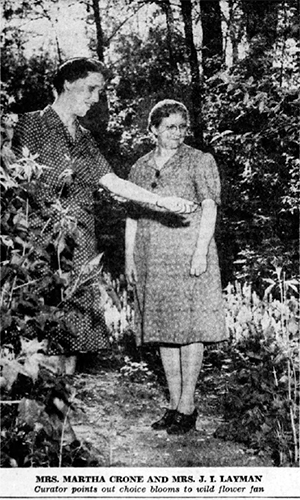
That was also the date that the Minneapolis Tribune ran a column titled "Springtime in the Wild Flower Garden," written by Martha Crone, discussing the spring flowers. In the article she states
You would scarcely believe that within view of the towering buildings of a busy metropolis there lies a bit of wilderness, the Wild Flower garden at Theodore Wirth Park. This 13 acre fence-enclosed area is a place apart where days are filled with planting and developing the endless possibilities that arise.
She also wrote "The narrow trails have been widened into graveled paths that wind gracefully through the glen, swamp and hills." This is different from the trails described in the 1943 Tribune article where there were "no formal paths in the Garden, only leafy trails that seem to carry no mark of passing feet." This change occurred with the Upland Garden development in 1944.(PDF of article)
On May 24 a second article appeared, this time in the Minneapolis Star titled "Sapling Now a Tree in Wild Flower Garden," which recounts the visit of Mrs. J. I. Layman of Hector MN who visited the Garden to inspect a tree she had planted as a sapling with Eloise Butler back in 1907. The article points out what’s blooming, says Martha worked for 20 years for Miss Butler, gives directions to the Garden and as to the poison Ivy, Martha says “we have to keep it, we get hundreds of visitors who want to see what it looks like." This was about the same language she later used in a June 10, 1951 newspaper article. The "20 years" working for Miss Butler is incorrect as Martha herself noted several times that it was 15 years. (1) (PDF of article.)
A large number of plants new to the Garden were introduced in the spring. "Native" refers to a plant found in the wild in Minnesota, at settlement time. "Introduced" means the plant is found here but not native. "Not native" means the plant is native to North America but not to Minnesota. If the species survived until the 1951 census it is noted in the list. Updated scientific names are given in [ ].

- Anemone globosa [Anemone multifida], Pacific Anemone, not native, no source given, not extant in 1951.
- Aquilegia flavescens, Yellow Columbine, Seeds, not native, from Frank Rose in Montana, not extant in 1951.
- Azalea calendulacea [Rhododendron calendulaceum] Flame Azalea, not native, from Robbins Blue Ridge Nursery, Ashford NC, extant in 1951.
- Azalea canescens [Rhododendron canescens] Mountain Azalea, not native, from Robbins Blue Ridge Nursery, extant in 1951.
- Azalea vaseyi [Rhododendron vaseyi] Pinkshell Azalea, not native, from Robbins Blue Ridge Nursery, extant in 1951.
- Azalea viscosa [Rhododendron viscosum] Swamp or White Azalea, not native, from Robbins Blue Ridge Nursery, extant in 1951.
- Erigeron concinnus, Navajo Fleabane, seeds, not native, no source given, not extant in 1951.
- Gilia aggregata [Ipomopsis aggregata, subsp aggregata], Scarlet Gilia, not native, seeds, no source given, not extant in 1951.
- Ginkgo biloba, Maidenhair tree, not native, 2 near south entrance, no source given, not extant in 1951.
- Iris prismatica - Slender Blue Iris, from Hendersons Nursery Greenburg Indiana, not native, not extant in 1951.
- Iris pseudacorus, Yellow Flag Iris, not native, from Robbins Blue Ridge Nursery, extant in 1951.
- Mitella staruopetala, Smallflower Miterwort, not native, from Frank Rose in Montana, not extant in 1951.
- Penstemon caelestinus [Penstemon albertinus] Alberta Beardtongue, Blue Western Penstemon. not native, from Frank Rose in Montana, extant in 1951.
- Penstemon ovatus var pinetorum [Penstemon wilcoxii] Wilcox’s Penstemon, not native, from Frank Rose in Montana, not extant in 1951.
- Ranunculus glaberrimius, Sagebrush buttercup, not native, from Frank Rose in Montana, not extant in 1951.
- Rhodora canadensis [Rhodora canadense] Rhodora, not native, from Robbins Blue Ridge Nursery, extant in 1951.
- Sphagnum moss
Next is a series of plants from Askov MN via Mr. & Mrs. Odell, which must have come from a garden or nursery as none are native and many are herb or ornamental garden plants. The source may have been Ferndale Nurseries which was located in Askov and was a source of plants for Eloise Butler and sometimes by Martha Crone. Some of these plants were still in the Garden at the time of her 1951 census.

- Astilbe biternata, Snowplume, extant in 1951. [Note: The name 'Snowplume' is usually assigned to another species of Astilbe, but in her 1951 census Martha Crone lists Snowplume as Astilbe biternata, which is normally named False Goat's-beard; the plant does show up in later census lists of the Garden and I have a photo of it from 2012.]
- Draba aizoides, Yellow Whitlow Grass, not native, not extant in 1951.
- Origanum vulgare, Oregano or Wild Marjoram, not native, extant in 1951.
- Thalictrum glauca - Yellow meadow Rue, not native, extant in 1951.
- Thymus alba, [Thymnus serpyllum], Creeping Thyme Mother of Thyme, introduced, extant in 1951.
- Trollius laxus, American Globe flower, not native, not extant in 1951.
- Trollius ledebourii, Globe Flower, not native, extant in 1951.
The first Hummingbird and Oriole arrived on May 17th. By the time June arrived 2,300 plants, including all the above, had been set out.
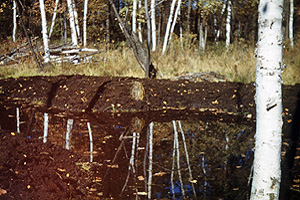
The pools Martha had dug in the marsh in 1947, to create a chain of three were enlarged. She wrote: “the pools along swamp trail (established last year) were enlarged and have been well stocked with water lilies, both white and yellow, lotus lily, pickerel-weed and other water loving plants.” (2). A photo that she took after the enlargement is on this page. More information on these pools here.
Again, a large number of plants new to the Garden were introduced in the summer. Only one species survived until the 1951 census - noted in the list. Updated scientific names are given in [ ].
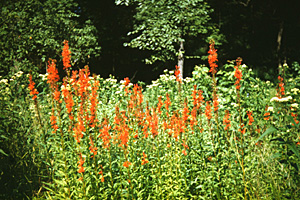
- Actinea lanata [unresolved name - usually assigned to Eriophyllum lanatum] Common Woolly Sunflower, not native, from Frank Rose in Montana.
- Aster integrifolius [Eurybia integrifolia] Stiffstem Aster, not native, from Frank Rose in Montana.
- Balsamorhiza sagittata, Balsam Root, not native, from Frank Rose in Montana.
- Colchortus apiculatus, Pointedtip Mariposa Lily, not native, from Frank Rose in Montana.
- Cypripedium montanum, Mountain Lady’s-slipper, not native, from Frank Rose in Montana.
- Iris missouriensis, Rocky Mountain iris, not native, from Frank Rose in Montana.
- Mertensia longiflora, Small Bluebells, not native, from Frank Rose in Montana.
- Penstemon flavescens - High Mountain Penstemon, not native, from Frank Rose in Montana.
- Penstemon nitidus, Waxleaf Penstemon, not native, from Frank Rose in Montana.
- Rnaunculus montanensis [Ranunculus acriformis var. montanensis] Mountain Sharp Buttercup, not native, from Frank Rose in Montana.
- Trillium ovatum, Montana Trillium, Western Trillium, not native, from Frank Rose in Montana, extant in 1951.
- Tulipa dasystemon, Tulip variety seeds, no source.
- Viola bellidifolia [now Viola adunca var. adunca] Hooked Spur Violet, native, from Frank Rose in Montana.
- Viola linguifolia [Viola praemorsa, supsp. linguifolia] Upland yellow violet, not native, from Frank Rose in Montana.
- Viola orbiculata, Western Round-leaved violet, Darkwoods Violet, not native, from Frank Rose in Montana.
By the end of summer Martha had set out a total of over 6,400 plants, including all of the above, Her only bird notes during the summer was the sighting of a young Rose-breasted Grosbeak near the office on June 9th and that by August 22, only the Orioles, Meadow Larks and the Red-eyed Vireo were still singing.
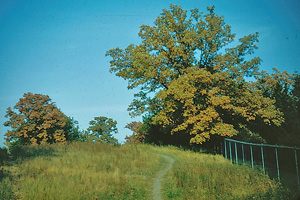
By the time the Garden closed the total count of plants set out in 1948 was 8,003. The following plants set out in the autumn are new to the Garden and we note which ones survived until the 1951 census, most did not. Updated scientific names are given in [ ].
- Calochortus macrocarpus, Sagebrush Mariposa Lily, not native, from Frank Rose in Montana.
- Caltha leptosepala var. rotundifolia [Caltha leptosepala var leptosepala] White Marsh Marigold, not native, from Frank Rose in Montana.
- Claytonia megarhiza, Alpine Spring Beauty, not native, from Frank Rose in Montana.
- Clematis columbiana, Rock Clematis, seeds, not native, no source given.
- Gentiana romanzovii [Gentiana algida], Whitish Gentian, Arctic Gentian, not native, from Frank Rose in Montana.
- Monarda didyma - American Bee balm, Red Monarda, introduced, no source given, extant in 1951.
- Muscari armeniacum, Grape Hyacinth, not native, no source given.
- Penstemon diphyllus, Twoleaf Beardtongue, not native, from Frank Rose in Montana.
- Penstemon confertus [Penstemon procerus] Western White Penstemon, Littleflower Penstemon, not native, from Frank Rose in Montana [Bloomed June 4 in 1949], extant in 1951.
- Sagittaria cuneata - Arumleaf Arrowhead, native, from Frank Rose in Montana.
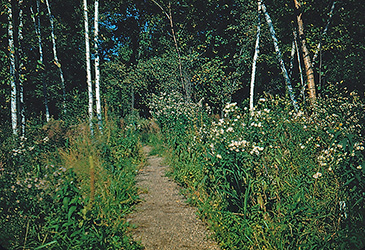
In addition Martha planted seeds of 63 species - listed on 4 pages of hand written notes. Most seeds were planted in flats near the office where they would over-winter as necessary for germination. Her planting continued throughout October and into November as late as November 19 when she mentions snow and sleet. The Garden season had been extended to the end of October in 1947.
As in the previous year, there were some existing species that were planted in very large numbers at various times during the year. Rather than list them by season, here it the list for the year of such plants:
Trillium nivale, Snow Trillium, 314 plants
Hepatica acutiloba, Sharp-lobed Hepatica, 187
Viola pedata, Bird’s-foot Violet, 400
Trillium grandiflorum, Large-flowered Trillium, 300
Liatris pycnostachya, Prairie Blazing Star, 190
Lysimachia nummularia, Moneywort, 105
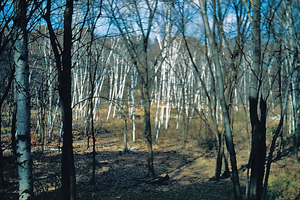
Many of these could be seedlings that Martha had seeded in flats the prior year.
She summarized the years activities in her annual report. Here are two additional items.
The water system installed in the fall of 1947 proved very beneficial. The spring and summer proved to be one of the driest, without water the loss would have been immeasurable.
At just over 16 inches of precipitation the entire year compared to almost 28 inches in an average year, 1948 was the driest since 1910. The month of March was most unusual - with a low of -27 degrees F to a high of 70 degrees F, the largest spread ever (97 degrees) for a single month locally.
Attendance: At some time after the war, perhaps with new Superintendent Charles Doell, Martha must have been asked to include attendance figures in her report as they become a staple of reports from that time up through the reports submitted by Ken Avery in the 1960s. Her 1948 report noted:
The upward trend in attendance attests to an ever increasing interest in our wild flowers, also the nature-loving public taking advantage of increased facilities. Approximately 43,000 patrons visited the garden during the season.
Martha had several workmen available this year. Fred Gau, Bjorne Herland in April only and then Ed Bruckelmyer from May onwards. He would return in 1949 for the month of April only and then return again in 1958. (3)
Notes:
(1) References to Crone stating she worked with Miss Butler for 15 years are found in a) Minneapolis Star January 10, 1944; b) The Fringed Gentian™ Vol. 26 no. 1; c) The Wild Gardener by Martha Hellander, page 95; d) Letter to the Friends membership by Cay Faragher, 1969.
(2) Annual Reports of the Garden Curator to the Board of Park Commissioners - dated February 26, 1949 to Charles E. Doell.
(3) Martha Crone records at Minnesota Historical Society.
Photo top of page: A section of the newly developed Upland Garden showing new paths, new plantings and identification stakes; photographed in May 1948 by Martha Crone.
Printable PDF file of this page.
Links to related pages:
- Abbreviated Life of Eloise Butler
- Martha Crone - 2nd Garden Curator
- Ken Avery - 3rd Curator and Gardener
- Cary George - 4th Gardener
- Our Native Plant Reserve - Short document on the origins of the Garden.
- Eloise Butler's writings, a selection of essays written by Eloise Butler on the early Garden years.
- Geography of the Garden- an illustrated tour
References:
Martha Crone's Garden Log and her 1951 Census of plants in the Garden.
Various papers and correspondence of Eloise Butler and Martha Crone in the collection of the Minnesota Historical Society.
Photos by Martha Crone are from her collection of Kodachromes that was given to the Friends by her daughter Janet following Martha's death in 1989.
Meeting Minutes and correspondence of The Friends of the Wild Flower Garden.
Historical Climatology of Minneapolis-St. Paul Area by Charles Fisk.